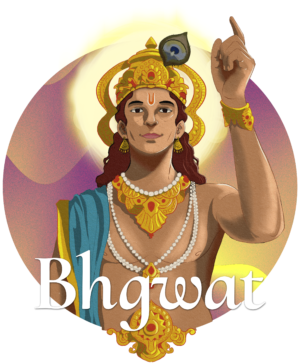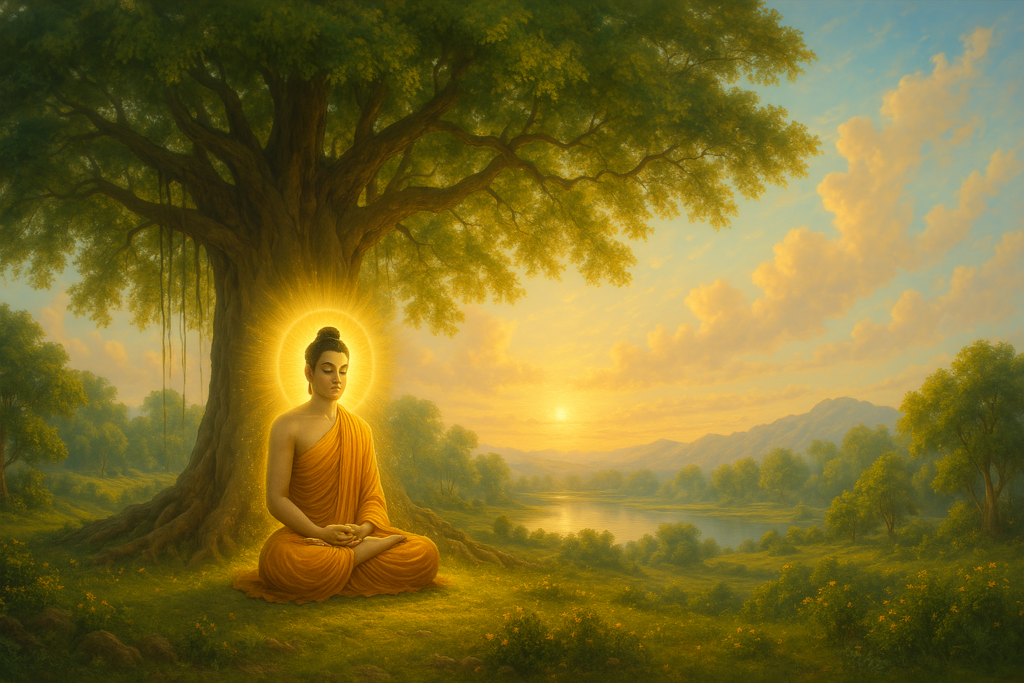🕉️ Lord Buddha in the Bhagavata Purana: A Divine Avatar of Compassion
📜 Introduction: A Buddha in the Book of Vishnu?
When we think of Buddha, we often picture a serene monk beneath the Bodhi tree. But what if we told you that the Bhagavata Purana, a sacred Hindu scripture, not only mentions Buddha—but hails him as an incarnation of Lord Vishnu?
“ततः कलौ संप्रवृत्ते सम्मोहाय सुरद्विषाम् | बुद्धो नाम जनस्यापि मया संस्थापितः किल ||”
(Bhagavata Purana 1.3.24)
“Then, in the age of Kali, I shall appear as Buddha to bewilder those who are envious of the faithful.”
Buckle up, because the tale of Buddha in Hinduism is not just spiritual—it’s divine strategy in action.
👑 The Birth of a Prince, the Seed of an Avatar
In the tranquil kingdom of Kapilavastu, Queen Maya Devi dreamed of a divine white elephant. Soon after, she gave birth to a radiant prince: Siddhartha Gautama.
Astrologers foresaw greatness: he would either become a universal king or a renounced sage. Fearing the latter, King Suddhodana tried to shield the young prince from all suffering.
🖼️ Suggested Image: Baby Siddhartha in a golden cradle, with celestial beings showering flowers.
🚪 The Four Sights: Shattering the Palace Illusion
Despite the walls of luxury, truth found its way in. During a chariot ride beyond the palace, Siddhartha saw:
-
Old age
-
Disease
-
Death
-
A wandering monk
These revelations stirred a deep calling. At just 29, Siddhartha left behind wife Yashodhara, newborn Rahula, and royal life to seek the truth of existence.
🧘 The Enlightenment: Under the Bodhi Tree
After years of harsh asceticism, Siddhartha sat under a Bodhi tree in Bodh Gaya. He faced Mara, the tempter of illusion—but remained unmoved.
As dawn broke, he awakened. He saw the wheel of suffering and the way out.
✨ “With the rising of the morning star, Siddhartha became the Buddha—the Awakened One.”
This moment wasn’t just personal enlightenment. It was Vishnu’s divine Leela playing out in silence.
🖼️ Suggested Image: Siddhartha meditating under the Bodhi tree, Mara’s illusions fading around him.
🌼 Buddha’s Message: Ahimsa Over Animal Sacrifice
Why would Lord Vishnu take a form that discouraged Vedic rituals?
Because, as scriptures suggest, adharmic forces had begun misusing the Vedas—especially to justify violent animal sacrifices.
“na veda-dṛṣṭo nāsty-ātmā yaḥ paśu-ghnaḥ sa ucyate”
“He who kills animals in the name of the Vedas is not spiritual—he is a butcher.”
Thus, Buddha’s rejection of rituals wasn’t rebellion—it was a divine reset button to preserve the soul of dharma.
🔄 Dharma Chakra Pravartan: Turning the Wheel of Truth
Buddha’s first sermon at Sarnath unveiled the Four Noble Truths and the Eightfold Path:
-
Suffering is real
-
It arises from desire
-
It can end
-
There’s a path to end it
He wasn’t denying karma, rebirth, or moksha. These concepts were aligned with Vedantic thought—he simply removed the rituals and refocused on inner purity.
🖼️ Suggested Image: Buddha teaching his first disciples with the Dharma Chakra behind him.
🔚 Parinirvana: Beyond the Cycle
At age 80, in Kushinagar, the Buddha lay between twin sal trees, surrounded by disciples. With calm breath and content eyes, he entered Parinirvana—a state beyond death and rebirth.
His final words echoed his mission:
“Appo deepo bhava” – Be a light unto yourself.
🔱 Buddha in the Bhavishya Purana
Other Puranas also confirm Buddha’s divine purpose:
“Ajina-vasanam buddham, nānā-dṛṣṭi-vibhūṣitam |
Dasyūn saṁhārakaṁ vande, devaṁ kāla-yugaṁ yuge ||”
(Bhavishya Purana)
“Wearing garments of bark, Buddha, diverse in view, shall destroy the impious in Kali Yuga.”
In short, he was sent to protect the masses from spiritual manipulation. He came not to deny Sanatana Dharma, but to cleanse it of corruption.
🌟 Conclusion: Buddha – The Silent Avatar
Unlike Rama’s arrows or Krishna’s flute, Buddha’s power was silence. He didn’t fight demons with weapons but with wisdom.
To millions, he was the founder of Buddhism. To Hindus, he is also the ninth avatar of Vishnu, a quiet protector who used compassion as his sword.
💬 Pull Quote:
“In a time when rituals had lost their soul, Lord Vishnu came as Buddha—to remind us of the yajna of self-awareness.”
📌 For Your bhgwat.com Readers
This story is part of a divine continuum—where avatars evolve to meet the needs of the age. Buddha’s teachings, often seen as outside Hinduism, are in fact a protective layer woven by Vishnu Himself.
So when we speak of Lord Buddha, we speak of a Hindu avatar, a master of dharma through peace, and a reminder that compassion is the highest form of wisdom.



